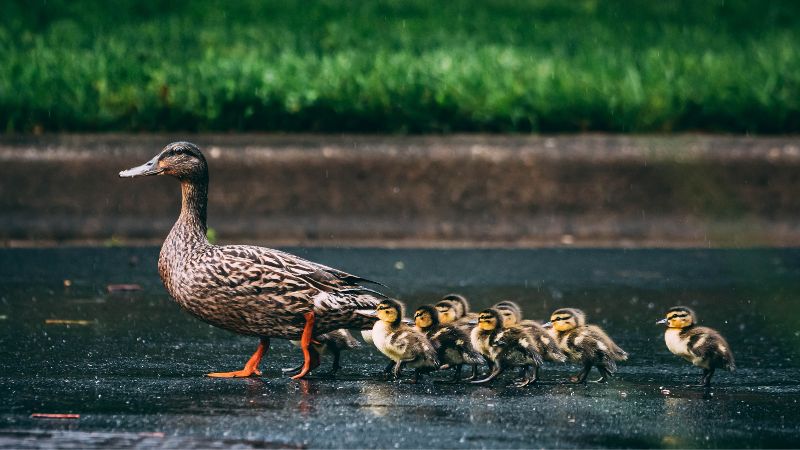Why Do Ducks Have Feathers? Explained

Ducks are fascinating creatures known for their unique adaptations, including their feathers. But why do ducks have feathers? This question has been asked by scientists, ornithologists, and bird enthusiasts alike. Feathers are a crucial aspect of a duck’s biology, playing a significant role in their survival and overall well-being.
Feathers are not just for show, they provide insulation, aid in flight, and assist with waterproofing. They also serve as a means of communication and courtship, with certain ducks exhibiting brightly colored and intricate feather patterns to attract mates. Understanding the purpose of feathers in ducks can give us insight into the intricate and fascinating world of avian biology.
Do Ducks Have Feathers Or Fur?
Ducks do not have fur, they have feathers. Feathers are a unique characteristic of birds and essential to their biology. Unlike fur, which is made up of hair-like structures, feathers are complex structures of several parts, including the shaft, vane, and barbs. The structure and composition of feathers are specifically designed to provide a range of benefits to birds, including insulation, flight, waterproofing, and communication.
Feathers are also much more versatile than fur, allowing birds to perform various functions and activities. For example, feathers provide insulation, keeping birds warm in cold temperatures and waterproofing, allowing birds to float and swim without becoming waterlogged. Feathers aid in flight, providing lift and allowing birds to maneuver in the air. The intricate structure of feathers also allows birds to communicate and display intricate courtship displays, further emphasizing the versatility of feathers and their importance in the lives of birds.
Why Do Ducks Have Feathers?
Feathers are a unique characteristic of birds and play a vital role in their survival and well-being. Ducks’ feathers serve several purposes, including insulation, flight, waterproofing, and communication. The structure and composition of feathers are specifically designed to provide these benefits to ducks, making them an essential aspect of their biology.
Insulation
One of the primary functions of feathers in ducks is insulation. Ducks are equipped with a dense layer of feathers that help to keep them warm in cold temperatures. The feathers trap air close to the duck’s skin, providing insulation that helps to retain heat. This is especially important for ducks that live in cold environments or during the winter months when temperatures can drop dramatically. The insulation provided by feathers is so effective that ducks can remain active even in extremely cold conditions, allowing them to forage for food and maintain their energy levels.
Flight
Another important function of feathers in ducks is flight. Feathers provide lift and help ducks to stay airborne. The structure of feathers is specifically designed to support flight, with the shafts of feathers being strong and flexible and the vanes providing surface area for lift. Ducks also use their feathers to maneuver in the air, adjusting the angle of their feathers to control their direction and speed.
Waterproofing
Additionally, feathers provide waterproofing, keeping ducks dry even in the wettest conditions. The waterproofing provided by feathers is essential for ducks as it allows them to float and swim without becoming waterlogged, making it easier for them to forage for food and escape predators.
Communication and courtship
Feathers play a crucial role in communication and courtship in ducks. Certain ducks exhibit brightly colored and intricate feather patterns, which they use to attract mates and signal their dominance. During courtship displays, male ducks show off their feathers to demonstrate their fitness and viability as potential mates, attracting the attention of female ducks. These feather displays also communicate between ducks, allowing them to signal aggression and establish dominance within a group. The versatility and importance of feathers in the social lives of ducks further highlight their significance in avian biology.
Feathers play a crucial role in the lives of ducks, providing insulation, aiding in flight, waterproofing, and serving as a means of communication and courtship. Understanding the purpose of feathers in ducks can give us insight into the complex and fascinating world of avian biology.
The Structure of Feathers
The structure of feathers is complex and highly specialized, designed to provide a range of benefits to birds, including insulation, flight, and waterproofing. A feather is made up of several different parts, including the shaft, vane, and barbs.
The shaft is the central stem of the feather, providing support and structure to the feather. The vane is the flat, expanded part of the feather, providing surface area for lift and insulation. The barbs are the fine, branching structures that extend from the vane, forming the soft and fluffy texture of the feather.
The structure of feathers allows them to perform a range of functions, from insulation and waterproofing to flight. For example, the vane provides surface area for lift, allowing birds to stay airborne. The soft and fluffy texture of the feathers, created by the barbs, provides insulation, trapping air close to the bird’s skin and retaining heat.
Additionally, the waterproofing provided by feathers is essential for birds like ducks, allowing them to float and swim without becoming waterlogged. The intricate structure of feathers and their specialized adaptations highlight the importance of feathers in the lives of birds and the complex world of avian biology.
Feathers vs. Fur
Feathers and fur are structures found on animals that serve a range of functions, but they are fundamentally different. While fur is made up of hair-like structures that grow from the skin, feathers are complex structures of several different parts, including the shaft, vane, and barbs. The structure of feathers is specifically designed to provide a range of benefits to birds, including insulation, flight, and waterproofing.
In contrast, fur provides insulation and protection from the elements but does not serve the same functions as feathers. For example, fur does not provide lift, nor does it have the waterproofing properties that feathers possess. The structure of the fur is also not as complex as feathers, with fur being made up of simple hair-like structures that grow from the skin.
What Do Ducks Have Under The Feathers?
Underneath their feathers, ducks have a layer of down feathers that provide insulation and warmth. The down feathers are soft, fluffy, and short and are arranged in such a way as to trap air close to the duck’s skin. This helps to retain heat and keep the duck warm, even in the coldest conditions. The down feathers also provide a cushioning effect, helping to protect the duck’s skin from injury and providing comfort.
In addition to the down feathers, ducks have a layer of skin and muscle covering their bones and organs. This layer provides protection and support to the duck’s internal structures, helping to keep them safe and functioning properly. The skin of ducks is also waterproof, helping to prevent water from penetrating through to the underlying tissues and organs. This waterproofing is essential for ducks, allowing them to float and swim without becoming waterlogged.

